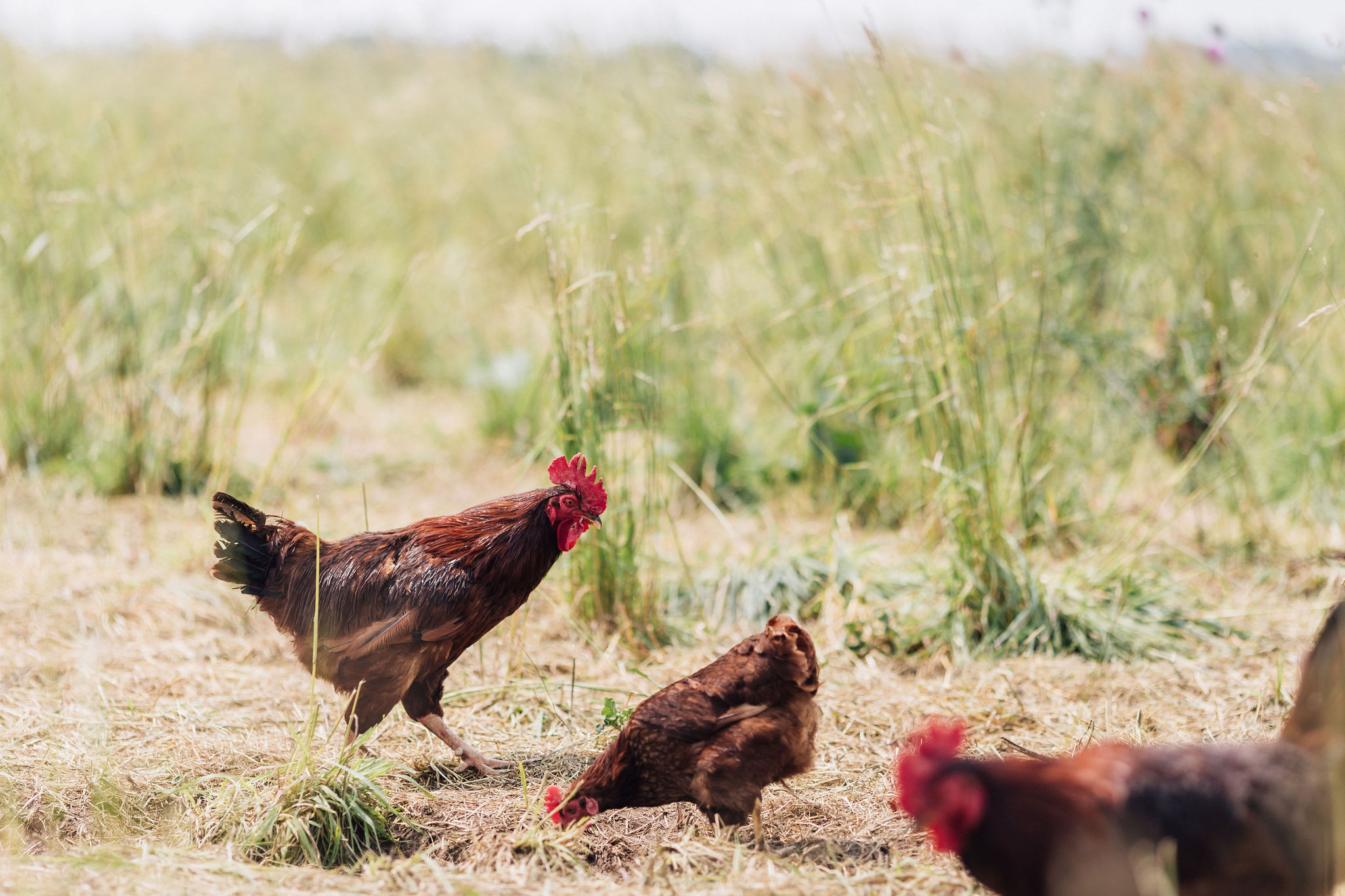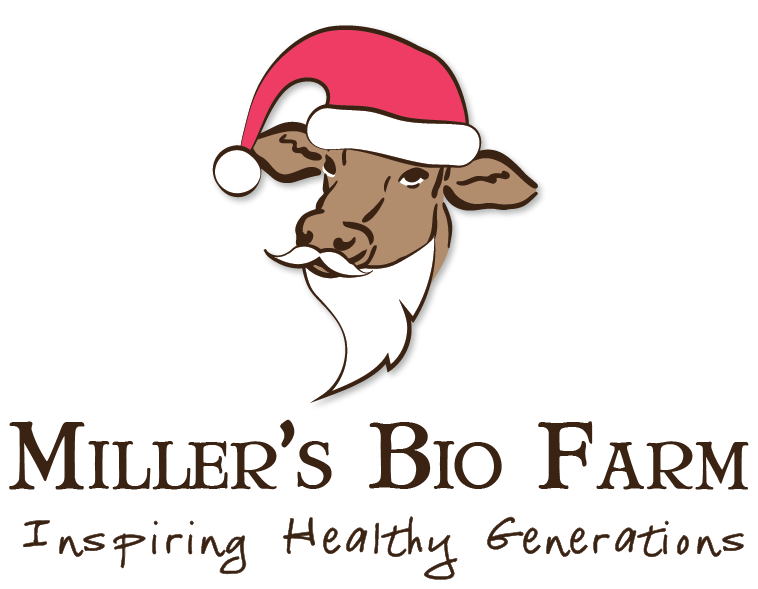What's in our natural egg feed? And why is it in there anyway?
posted on
March 29, 2024

New & Honest Egg Feed
Our egg farmers recently switched to a new, natural, and 100% honest feed supplier (read the juicy details in last week's blog post). We are thrilled that they'll work with us to create a feed that fits our natural requirements:
- Chemical-free
- GMO-free
- Soy-free
- Corn-free
- Ingredients from local, traceable farms as much as possible; certified organic if from a distributor
- The least amount of synthetic ingredients possible
- Provides optimal nutrition for our birds
- Produces eggs packed with the most nutrition possible
This will be a long process and may take up to a year to get a blend that everyone is satisfied with. But, we've made good progress so far.
The current feed contains:
Oats, rolled wheat, peas, alfalfa hay leaves, barley, fishmeal, sesame meal, raw liquid goat whey, vitamins, minerals, and probiotics.
It’s important to note that most farms would simply list the ingredients like they're shown above. But, at Miller’s Bio Farm, we provide full transparency. And that includes doing the research and providing you with all the nitty gritty details about the feed, including the ingredients in the ingredients (view the complete list at the bottom of this post).
When you do it this way, you can be surprised at what you find. And then you start to ask questions about how to most naturally provide optimal nutrition for the birds, which then transfers optimal nutrition to the eggs.
I've emailed back and forth with the egg farmers and the new feed supplier. I read the technical sheets for every single ingredient (and reached out to the companies if I needed more info). I had a 45-minute phone call with a feed specialist from Fertrell. I've done some additional research online. Everything has been very enlightening.
From all that research, I was able to answer all the questions from our amazing and thoughtful customers.
Top Laying Hen Feed Questions & Answers
What can’t the hens just forage for food naturally?
Birds in the wild eat a very diverse diet. They are foragers and eat a range of grasses, seeds, bugs, and other things they can find. They would be fairly happy this way, especially in the warmer months. But… when the grass isn’t growing, they may not find enough food. They may not produce many eggs (if any at all) in the winter. And finally, they may fall into poor health.
This is not what we want. Our eggs are farmed eggs. We want to provide optimal nutrition and a happy lifestyle to our birds year round. I mean, this is the least we can do to thank them for providing us with beautiful eggs!
Why do you need all those extra vitamins and minerals?
The nutritionist from Fertrell said that the hens aren’t eating a diverse enough diet. They’re mainly being sustained on a handful of different grains. And because of generally depleted soils, the grains don’t have as much nutritional value compared to a hundred years ago.
It’s not enough, so the feed needs to be supplemented. If we didn’t supplement, hen health and egg production would go down a lot. And that means that our egg price would go up a lot.
The new feed supplier has this in mind and is considering adding other ingredients to the feed to increase its diversity. Here’s some of the ingredients being considered:
Cricket powder, black fly larvae, flaxseed, cod liver oil, dried herring, dried beets, dried pumpkin, dried cucumbers, dried broccoli, dried kale, sprouted sesame seeds, oregano, hemp seed oil, nutritional yeast, parsley, nettle, chlorella, and chaga mushroom.
The hope is that, by diversifying the ingredients, we can reduce the amount of supplemental vitamins in the feed.
Why do you need synthetic vitamins and supplements?
A majority of the supplements added to the current feed are natural. But, there are a few that are synthetic (DL Methionine amino acid and the B vitamins). The nutritionist from Fertrell said that they could make us a special nutri-balancer without the synthetic vitamins, but they wouldn’t stand behind it as a complete supplement. The birds wouldn’t maintain good health, and egg production would drop by 5-20%.
We will work to reduce synthetic supplements by diversifying the feed with natural ingredients. It will take time.
*Interesting fact: Poultry diets are the only diet in “certified organic” where synthetic amino acids are allowed.
Why are egg yolks yellow or orange?
The color of the yolk corresponds to the chemical compounds present in what the birds are eating.
When birds are pasture raised, they eat a variety of foraged foods like grasses, seeds, and bugs. In the warmer months, these foods naturally contain carotenoids (fat-soluble pigments) that make the yolks darker. But, when birds are primarily fed a diet of wheat, corn, and soy, their yolks are lighter in color.
Big ag has caught on to consumer demand for darker yolks, so they figured out how to add synthetic colors (chemicals like Rovimix Carophyll Yellow or Lucantin Red) or natural colors (like marigold or paprika) to make the yolks dark… even if the birds aren’t on pasture.
Is yolk color an indicator of a nutritious egg?
Because of added feed colorants (which is super common now), sadly a dark orange yolk no longer means a more nutritious egg.
Today, the only way to know how nutritious your eggs are is to know your farmer. Truly pastured eggs offer more nutrition (more vitamins, omega-3s, antioxidants, etc) because the birds are naturally healthier. That health is transferred to the egg and then to you.
Will you continue to add natural ingredients that make the yolks orange year round?
Yes and no.
Marigold and paprika have been removed and most likely won't be added. Although they add antioxidants and vitamin A, the only real reason they’re in the feed is for the yolk color.
Instead, we’re looking to feed fresh or dried greens to the birds year round (kale, chard, alfalfa etc). This not only is something that the birds love but it also adds quality natural nutrition. Greens also contain the same carotenoids in marigold and paprika that make the yolks darker.
Will the egg price change with the feed changes?
Yes. The new feed will be a higher quality and more natural. And, that costs more. Egg prices will go up this year. We're anticipating the increase to be around $1 per dozen, but we just don't know exactly how much yet.
Complete List of Current Egg Feed Ingredients
*updated 3/29/24
MAIN FEED INGREDIENTS
This makes up 90%+ of the feed. About 20% of the grains below are sourced from local chemical-free farms and about 80% come from certified organic farms that we don't personally know. All ingredients are GMO-free.
- Oats
- Rolled wheat
- Peas
- Alfalfa hay leaves
- Barley
SUPPLEMENTAL FEED INGREDIENTS
All supplements are certified for organic and GMO-free. There are no added oils or additives (like preservatives or anti-caking agents). The loooong lists below are exactly what's in them. There's a nutritional reason for each and every one.
- Poultry Nutri-Balancer (from Fertrell): Monocalcium Phosphate, Organic Dehydrated Kelp Meal, Salt, DL Methionine, Calcium Carbonate, Vitamin A Supplement, Vitamin D3 Supplement, Vitamin E Supplement, Menadione Dimethylpyrimidinol Bisulfite, Riboflavin Supplement, D-Calcium Pantothenic Acid, Niacin Supplement, Choline Chloride, Vitamin B12 Supplement, Folic Acid, Thiamine Mononitrate, Pyridoxine Hydrochloride, Biotin, Manganese Sulfate, Ferrous Sulfate, Zinc Sulfate, Copper
Sulfate, Sodium Selenite, Dried Aspergillus oryzae Fermentation Extract, Active Dry Yeast, Dried Lactobacillus acidophilus Fermentation product, Dried Lactobacillus casei Fermentation product, Dried Lactobacillus plantarum Fermentation product, Dried Enterococcus faecium Fermentation product, Dried Bacillus licheniformis Fermentation product, Dried Bacillus subtilis Fermentation Product. - Fishmeal (Fertrell's FERFISH): 100% whole sardine meal that is wild-caught off the coast of South America. The fishery has a sustainability certificate so they only harvest what they can take to sustainably keep the fish population going for the future. We used mixed tocopherols as the preservative (the only preservative allowed under Organic Regulations) and never use Ethoxyquin. The fish meal is used in the ration both as a great source of protein and amino acids, but also because it attracts the birds to their feed and actually helps them digest it better.
- Sesame Meal (from Tipple M Farms): Ground sesame seeds
- Aragonite: This is just ground aragonite rocks
- York Calcium Chips: Limestone
- Monocal Phos (from Fertrell): Monocalcium phosphate (which is phosphorous and calcium that has been chemically bonded together)
- Spnutzym Nutri-Zyme (from Fertrell): Enzymes derived from lactic acid bacteria and ground limestone. The enzymes are grown on dairy but there's no dairy in the final product.
- Goat Whey (raw from a local farmer): From local pasture raised goats.
- Redmond Salt: Unrefined ancient sea salt from Salt Lake City, Utah which contains 60+ naturally-occurring trace minerals.




